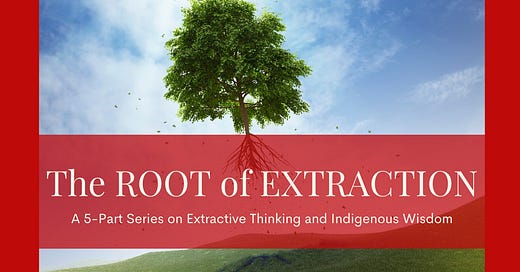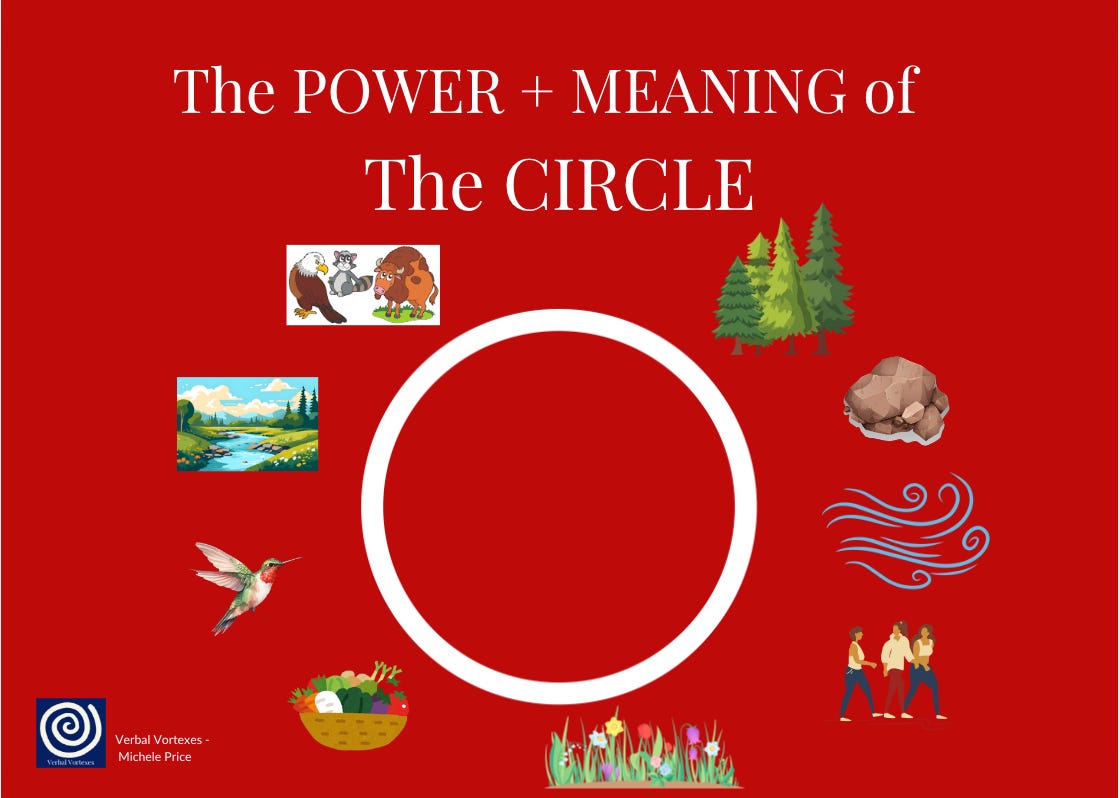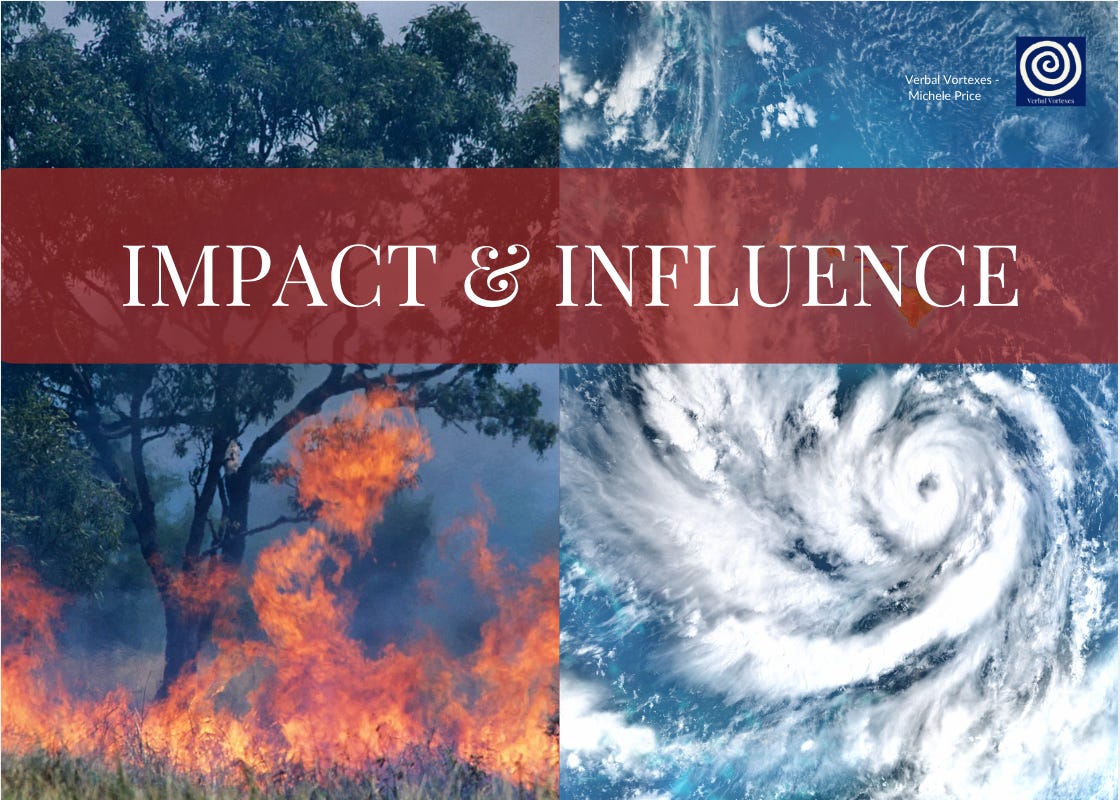The Cost of Extraction: A World Out of Balance-Extractive Thinking #1
Reclaiming Harmony Through an Indigenous Lens
How will we approach »»» Reclaiming Balance and who is willing to face the consequences of extractive thinking in a world of shared resources?
This is a 5 part series for Leaders + Learners where you and I take an honest look at “What is Extractive Thinking?”
Here is a succinct outline of what you can expect in this first of five posts in this series here on Verbal Vortexes.
Thank you for joining me and my mind-heart-gut approach to where we can do the work both internally (with our inner game) and externally (our expression the outer game)
What’s Extraction
The Indigenous Circle: A Framework for Balance
Consequences of Extractive Thinking
Extractive Thinking in Leadership
Restoring the Balance: Lessons from Indigenous Wisdom
Practical Action + Conclusion
A gentle reminder, this body of work you are reading and listening to here on Verbal Vortexes is produced from Dyslexic Thinking. What do you know or remember learning with me about Dyslexic Thinking?
Share with me in the comments below.
What is Extraction?
Extraction is the process of removing valuable resources from the natural environment or from communities for economic gain, often with little regard for the long-term consequences or the interconnected web of life.
These resources can be tangible, such as minerals, timber, or oil, or intangible, such as the extraction of labor or cultural knowledge.
Extractive thinking is deeply ingrained in modern systems and institutions. It is rooted in the colonial history of resource exploitation, where European powers extracted wealth from Indigenous lands and peoples without concern for their well-being or the ecological balance.
This mindset has persisted into contemporary times, shaping our economies, leadership, and societal structures in several key ways:
Economic systems prioritize short-term profit and economic growth over long-term ecological and social sustainability, often leading to resource depletion, environmental degradation, and social inequalities.
Political and legal systems frequently favor the interests of corporations and powerful entities over the rights and well-being of local communities and the environment.
Educational systems often perpetuate extractive thinking by emphasizing individual success and competition over collaboration and the collective well-being of society and the planet.
Social norms and cultural narratives reinforce the idea that human beings are separate from, and superior to, the natural world, justifying the exploitation of nature for human benefit.
By critically examining these structures and reevaluating our relationship with the natural world, we can begin to challenge extractive thinking and move towards a more balanced and sustainable future that values interconnectedness, equity, and long-term well-being.
The Indigenous Circle: Embracing Equal Value for All Beings
The Indigenous circle is a symbol of interconnectedness and balance that has deep roots in many Indigenous cultures worldwide. It represents the belief that all beings – trees, animals, water, rocks, plants, humans, and birds – are interconnected and have equal value in the web of life. This concept stands in stark contrast to the hierarchies and exploitation inherent in extractive thinking.
In the Indigenous circle, every being has a unique role and purpose within the ecosystem, contributing to the overall harmony and balance of the natural world. This perspective fosters a deep sense of respect, reciprocity, and responsibility towards all life forms, recognizing that the well-being of each depends on the well-being of the whole.
Some key aspects of the Indigenous circle include:
Interconnectedness: All beings are connected through intricate relationships and mutual dependencies, which shape and sustain the web of life.
Balance and harmony: The well-being of the natural world relies on maintaining equilibrium and respecting the balance between all beings.
Reciprocity and respect: Humans have a responsibility to give back to the natural world and treat all beings with respect, acknowledging their inherent value and rights.
Seven generations principle: Decision-making should consider the impact on the next seven generations, ensuring that the actions we take today create a sustainable future for all beings.
By embracing the wisdom of the Indigenous circle, we can challenge extractive thinking and cultivate a more balanced and sustainable future. This shift in perspective encourages us to value interconnectedness, respect the inherent worth of all beings, and prioritize long-term ecological and social well-being.
Extractive Thinking: Disrupting the Balance of Interconnectedness
The foundation of extractive thinking lies in positioning humans as entitled takers, separate from and superior to the natural world. This mindset has significantly disrupted the balance of interconnectedness, leading to widespread environmental degradation and social inequalities.
In contrast to the Indigenous circle's belief in equal value for all beings, extractive thinking prioritizes human needs and desires over the well-being of the environment and other life forms. This has resulted in the following consequences:
Resource depletion and environmental degradation: The relentless pursuit of economic growth has led to overconsumption and exploitation of natural resources, causing irreversible damage to ecosystems and contributing to climate change.
Loss of biodiversity: The destruction of habitats and the overexploitation of species have caused a significant decline in biodiversity, threatening the stability and resilience of the natural world.
Social inequalities and exploitation: Extractive thinking has fueled colonialism, labor exploitation, and the displacement of Indigenous communities, leading to widespread social injustice and human rights violations.
Disconnection from nature: By viewing humans as separate from and superior to the natural world, extractive thinking has eroded our sense of interconnectedness and fostered a culture of apathy towards environmental issues.
As we grapple with the consequences of extractive thinking, it is crucial to reevaluate our relationship with the natural world and adopt a more balanced perspective that values interconnectedness, equity, and long-term well-being.
By embracing the wisdom of the Indigenous circle and challenging the systems that perpetuate extractive thinking, we can work towards a more sustainable and just future for all beings.
Unveiling Extractive Thinking's Impact and Influence
To better understand the consequences of extractive thinking and how it has shaped our world, we will explore several key themes throughout this series:
Extraction's Environmental Impact: We will examine how extractive thinking has fueled the overexploitation of natural resources and the resulting environmental degradation, including climate change, pollution, and the loss of biodiversity.
Social Inequalities and Exploitation: This theme will delve into the social consequences of extractive thinking, such as labor exploitation, Indigenous displacement, and the perpetuation of social injustices.
Cultural Displacement and Assimilation: We will discuss how extractive thinking has contributed to the erosion of cultural heritage, knowledge, and traditions, particularly among Indigenous communities.
Extractive Thinking in Leadership and Decision-Making: In this theme, we will explore how extractive thinking has influenced leadership decisions across various sectors, prioritizing short-term economic gains over long-term well-being and sustainability.
By examining these key themes, we aim to shed light on the far-reaching impact of extractive thinking and emphasize the urgency of adopting a more balanced and sustainable approach to our relationship with the natural world and each other.
Extractive Thinking: Entrenched in Colonialism, Capitalism, and Patriarchy
Extractive thinking is deeply embedded in the systems of colonialism, capitalism, and patriarchy.
These systems have historically benefited from exploitation, fueling the imbalanced power dynamics and resource extraction that characterize extractive thinking. Here's how these systems have perpetuated and reinforced extractive thinking:
Colonialism: Colonialism is rooted in the idea that certain groups have the right to dominate, exploit, and extract resources from other lands and peoples. This mindset has led to the displacement, assimilation, and exploitation of Indigenous communities worldwide.
Capitalism: Capitalism prioritizes economic growth, profit, and the accumulation of wealth, often at the expense of the environment and marginalized communities. This system incentivizes extractive practices, such as resource exploitation, labor exploitation, and wealth inequality.
Patriarchy: Patriarchy perpetuates a hierarchical system that privileges certain groups, particularly men, and perpetuates the exploitation and marginalization of others, such as women, non-binary individuals, and other marginalized groups.
This power dynamic reinforces extractive thinking by promoting dominance and control over others.
These interconnected systems have reinforced extractive thinking by normalizing exploitation and marginalization as acceptable means to achieve economic, political, and social power. As we work towards dismantling extractive thinking, it is essential to recognize its historical roots in these systems and strive to build more equitable, inclusive, and sustainable alternatives that prioritize balance, interconnectedness, and respect for all beings.
Manifestations of Extractive Thinking in Industries and Leadership
Extractive thinking permeates various industries and decision-making processes, often resulting in the exploitation of natural resources, labor, and ecosystems. Here are some examples of how extractive thinking manifests across sectors:
Natural Resources: Mining, logging, and fossil fuel extraction are driven by extractive thinking, often leading to environmental destruction, habitat loss, and resource depletion. For example, the tar sands extraction in Alberta, Canada, has caused significant deforestation, water pollution, and greenhouse gas emissions.
Agriculture: Industrial agriculture practices, such as monoculture farming and heavy reliance on pesticides, prioritize profit and efficiency at the expense of biodiversity, soil health, and the well-being of small-scale farmers. The exploitation of migrant farmworkers in many parts of the world exemplifies labor extraction in this sector.
Labor: Extractive thinking in labor practices manifests in worker exploitation, low wages, poor working conditions, and disregard for work-life balance. Fast fashion is a prime example, relying on low-wage labor and unsustainable production practices to drive profits.
Ecosystems: Overfishing and deforestation are consequences of extractive thinking in managing ecosystems, prioritizing short-term economic gains over long-term sustainability. The Amazon rainforest deforestation for cattle ranching and soybean production showcases this exploitative mindset.
In leadership and decision-making, extractive thinking often involves prioritizing short-term profits, exploiting resources and labor, and disregarding the long-term consequences on people and the environment.
For example, corporate CEOs may choose to cut costs through layoffs or lower wages rather than prioritizing worker well-being and job security.
By identifying and challenging these manifestations of extractive thinking, we can work towards fostering more balanced, sustainable, and equitable practices across industries and sectors.
What’s Next
Indigenous Circle: Wisdom for Challenging Extractive Thinking
In the next part of our five-part series, we will delve into the rich symbolism and wisdom of the Indigenous circle. As a powerful representation of interconnectedness and balance, the Indigenous circle offers valuable insights for understanding and challenging extractive thinking.
We will explore the significance of the circle, its alignment with sustainable decision-making, and the importance of embracing Indigenous wisdom on our journey towards a more balanced and interconnected world.
Join me as we discover together this transformative exploration of the Indigenous circle and its potential for shaping a sustainable and equitable future.
What Now?
Founding Members receive ALL the Guides + Workbooks created in 2024.
The goal is to work with you to implement what you learn in the writing offered here in Verbal Vortexes.
The above Impact Guide is a gift to all NEW Subscribers in October. It is a robust 89-page guide using a brain-friendly combination of images and data so that you can work with it and implement it immediately.
The "Post-Pandemic Decision-Making" Impact Guide is an invaluable, brain-friendly resource designed to empower readers in the new normal. Spanning 89 pages, this hybrid guidebook offers:
Inclusive learning: Catering to all types of learners and thinkers, ensuring everyone benefits from its wisdom.
Thought-provoking content: Challenging your current thinking and encouraging exploration of fresh ideas and a whole new set of questions.
Brain-friendly design: Easy-to-digest information that makes learning effortless and enjoyable.
Relevance: A focus on post-pandemic decision-making, addressing the unique challenges and opportunities of our changing world.
Ultimately, the "Post-Pandemic Decision-Making" Impact Guide is an essential tool for anyone looking to navigate the complexities of decision-making in today's rapidly evolving landscape.










